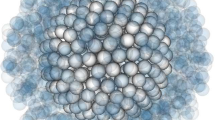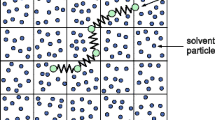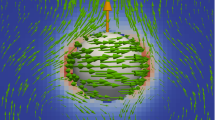Abstract
Kinetic theory is a mathematical framework intended to relate directly the most relevant characteristics of the molecular structure to the rheological behavior of the bulk system. In other words, kinetic theory is a micro-to-macro approach for solving the flow of complex fluids that circumvents the use of closure relations and offers a better physical description of the phenomena involved in the flow processes. Cornerstone models in kinetic theory employ beads, rods and springs for mimicking the molecular structure of the complex fluid. The generalized bead-rod-spring chain includes the most basic models in kinetic theory: the freely jointed bead-spring chain and the freely-jointed bead-rod chain. Configuration of simple coarse-grained models can be represented by an equivalent Fokker-Planck (FP) diffusion equation, which describes the evolution of the configuration distribution function in the physical and configurational spaces. FP equation can be a complex mathematical object, given its multidimensionality, and solving it explicitly can become a difficult task. Even more, in some cases, obtaining an equivalent FP equation is not possible given the complexity of the coarse-grained molecular model. Brownian dynamics can be employed as an alternative extensive numerical method for approaching the configuration distribution function of a given kinetic-theory model that avoid obtaining and/or resolving explicitly an equivalent FP equation. The validity of this discrete approach is based on the mathematical equivalence between a continuous diffusion equation and a stochastic differential equation as demonstrated by Itô in the 1940s. This paper presents a review of the fundamental issues in the BD simulation of the linear viscoelastic behavior of bead-rod-spring coarse grained models in dilute solution. In the first part of this work, the BD numerical technique is introduced. An overview of the mathematical framework of the BD and a review of the scope of applications are presented. Subsequently, the links between the rheology of complex fluids, the kinetic theory and the BD technique are established at the light of the stochastic nature of the bead-rod-spring models. Finally, the pertinence of the present state-of-the-art review is explained in terms of the increasing interest for the stochastic micro-to-macro approaches for solving complex fluids problems. In the second part of this paper, a detailed description of the BD algorithm used for simulating a small-amplitude oscillatory deformation test is given. Dynamic properties are employed throughout this work to characterise the linear viscoelastic behavior of bead-rod-spring models in dilute solution. In the third and fourth part of this article, an extensive discussion about the main issues of a BD simulation in linear viscoelasticity of diluted suspensions is tackled at the light of the classical multi-bead-spring chain model and the multi-bead-rod chain model, respectively. Kinematic formulations, integration schemes and expressions to calculate the stress tensor are revised for several classical models: Rouse and Zimm theories in the case of multi-bead-spring chains, and Kramers chain and semi-flexible filaments in the case of multi-bead-rod chains. The implemented BD technique is, on the one hand, validated in front of the analytical or exact numerical solutions known of the equivalent FP equations for those classic kinetic theory models; and, on the other hand, is control-set thanks to the analysis of the main numerical issues involved in a BD simulation. Finally, the review paper is closed by some concluding remarks.


























Similar content being viewed by others
Notes
Central Processing Unit.
Abbreviations
- Scalars:
-
Lightface
- Vectors and Tensors:
-
Boldface
- (A)ij :
-
Component ij of tensor A
- (A) t :
-
Tensor or vector A at instant t
References
Kröger M (2005) Models for polymeric and anisotropic liquids. Springer, Berlin
Langevin P (1908) Sur la théorie du mouvement Brownien. C R Acad Sci 146:530
Öttinger HC (1996) Stochastic processes in polymeric fluids. Springer, Berlin
Ermak DL, McCammon JA (1978) Brownian dynamics with hydrodynamic interactions. J Chem Phys 69(4):1352–1360
Pear MR, Weiner JH (1980) Brownian dynamics study of a polymer chain of linked rigid bodies. II. Results for longer chains. J Chem Phys 72(7):3939–3947
Hatzikiriakos SG, Vlassopoulos D (1996) Brownian dynamics simulations of shear-thickening in dilute polymer solutions. Rheol Acta 35(3):274–287
Agarwal US, Bhargava R, Mashelkar RA (1998) Brownian dynamics simulation of a polymer molecule in solution under elongational flow. J Chem Phys 108(4):1610–1617
Cass MJ, Heyes DM, English RJ (2007) Brownian dynamics simulations of associating diblock copolymers. Langmuir 23(12):6576–6587
Jin S, Collins LR (2007) Dynamics of dissolved polymer chains in isotropic turbulence. New J Phys 9:360
Venkataramani V, Sureshkumar R, Khomami B (2008) Coarse-grained modeling of macromolecular solutions using a configuration-based approach. J Rheol 52(5):1143–1177
Dwyer JD, Bloomfield VA (1993) Brownian dynamics simulations of probe and self-diffusion in concentrated protein and DNA solutions. Biophys J 65(5):1810–1816
Merlitz H, Rippe K, Kienin KV, Langowski J (1998) Looping dynamics of linear DNA molecules and the effect of DNA curvature: a study by Brownian dynamics simulation. Biophys J 74(2I):773–779
García de la Torre J, Pérez Sánchez HE, Ortega A, Hernández JG, Fernandes MX, Díaz FG (2003) Calculation of the solution properties of flexible macromolecules: methods and applications. Eur Biophys J 32(5):477–486
Kenward M, Dorfman KD (2009) Coarse-grained Brownian dynamics simulations of the 10–23 DNAzyme. Biophys J 97(10):2785–2793
Ansell GC, Dickinson E (1986) Brownian dynamics simulation of the fragmentation of a large colloidal floc in simple shear flow. J Colloid Interface Sci 110(1):73–81
Xue W, Grest GS (1989) Brownian dynamics simulations for interacting colloids in the presence of a shear flow. Phys Rev A 40(3):1709–1712
Heyes DM, Branka AC (1994) Brownian dynamics simulations of self-diffusion and shear viscosity of near-hard-sphere colloids. Phys Rev E 50(3):2377–2380
Bijsterbosch BH, Bos MTA, Dickinson E, Van Opheusden JHJ, Walstra P (1995) Brownian dynamics simulation of particle gel formation: from argon to yoghurt. Faraday Discuss 101:51–64
Tokuyama M (1999) Effective diffusion model on Brownian dynamics of hard-sphere colloidal suspensions. Physica A 265(3):333–340
Miyahara M, Watanabe S, Higashitani K (2006) Modeling adsorption and order formation by colloidal particles on a solid surface: a Brownian dynamics study. Chem Eng Sci 61(7):2142–2149
Schmidt M, Patrick Royall C, Van Blaaderen A, Dzubiella J (2008) Non-equilibrium sedimentation of colloids: confocal microscopy and Brownian dynamics simulations. J Phys Condens Matter 20(49)
Mori N, Fujioka H, Semura R, Nakamura K (2003) Brownian dynamics simulations for suspension of ellipsoids in liquid crystalline phase under simple shear flows. Rheol Acta 42(1):102–109
Siettos CI, Graham MD, Kevrekidis IG (2003) Coarse Brownian dynamics for nematic liquid crystals: bifurcation, projective integration, and control via stochastic simulation. J Chem Phys 118(22):10149–10156
Song YS, Youn JR (2004) Modeling of rheological behavior of nanocomposites by Brownian dynamics simulation. Korea-Australia Rheol J 16(4):201–212
Mendes MJ, Schmidt HK, Pasquali M (2008) Brownian dynamics simulations of single-wall carbon nanotube separation by type using dielectrophoresis. J Phys Chem B 112(25):7467–7477
Fakhri N, Tsyboulski DA, Cognet L, Weisman RB, Pasquali M (2009) Diameter-dependent bending dynamics of single-walled carbon nanotubes in liquids. Proc Natl Acad Sci USA 106(34):14219–14223
Cruz C, Illoul L, Chinesta F, Régnier G (2010) Effects of a bent structure on the linear viscoelastic response of diluted carbon nanotube suspensions. Rheol Acta 49(11):1141–1155
Bird RB, Curtiss CF, Amstrong RC, Hassager O (1987) Dynamics of polymer liquids. In: Kinetic theory, 2nd edn, vol 2. Wyley-Interscience, New York
Flory PJ (1969) Statistical mechanics of chain molecules. Wiley-Interscience, New York
Kirkwood JG (1967) Macromolecules, J.G. Kirkwood collected works. Gordon and Breach, New York
Larson RG (1999) The structure and rheology of complex fluids. Oxford University Press, London
Nayac R (1998) Molecular simulation of liquid crystal polymer flow: a wavelet-finite element analysis. PhD thesis, MIT, Cambridge, MA, USA
Lozinski A, Chauviere C (2003) A fast solver for Fokker-Planck equation applied to viscoelastic flows calculations: 2D FENE model. J Comput Phys 189(2):607–625
Lozinski A, Chauviere C, Fang J, Owens RG (2003) Fokker-Planck simulations of fast flows of melts and concentrated polymer solutions in complex geometries. J Rheol 47(2):535–561
Chauviere C, Fang J, Lozinski A, Owens RG (2003) On the numerical simulation of flows of polymer solutions using high-order methods based on the Fokker-Planck equation. Int J Mod Phys B 17(1–2):9–14
Suen JK, Nayak R, Armstrong RC, Brown RA (2003) A wavelet-Galerkin method for simulating the doi model with orientation-dependent rotational diffusivity. J Non-Newton Fluid Mech 114(2–3):197–228
Chauviere C, Lozinski A (2004) Simulation of dilute polymer solutions using a Fokker-Planck equation. Comput Fluids 33(5–6):687–696
Ammar A, Ryckelynck D, Chinesta F, Keunings R (2006) On the reduction of kinetic theory models related to finitely extensible dumbbells. J Non-Newton Fluid Mech 134(1–3):136–147
Ammar A, Mokdad B, Chinesta F, Keunings R (2006) A new family of solvers for some classes of multidimensional partial differential equations encountered in kinetic theory modeling of complex fluids. J Non-Newton Fluid Mech 139(3):153–176
Chinesta F, Ammar A, Falco A, Laso M (2007) On the reduction of stochastic kinetic theory models of complex fluids. Model Simul Mater Sci Eng 15(6):639–652
Mokdad B, Pruliere E, Ammar A, Chinesta F (2007) On the simulation of kinetic theory models of complex fluids using the Fokker-Planck approach. Appl Rheol 17(2):26494-1–26494-14
Ammar A, Chinesta F, Joyot P (2008) The nanometric and micrometric scales of the structure and mechanics of materials revisited: an introduction to the challenges of fully deterministic numerical descriptions. Int J Multiscale Comput Eng 6(3):191–213
Ammar A, Pruliere E, Chinesta F, Laso M (2009) Reduced numerical modeling of flows involving liquid-crystalline polymers. J Non-Newton Fluid Mech 160(2–3):140–156
Pruliere E, Ammar A, El Kissi N, Chinesta F (2009) Recirculating flows involving short fiber suspensions: numerical difficulties and efficient advanced micro-macro solvers. Arch Comput Methods Eng 16(1):1–30
Leonenko GM, Phillips TN (2009) On the solution of the Fokker-Planck equation using a high-order reduced basis approximation. Comput Methods Appl Math 199(1–4):158–168
Ammar A, Normandin M, Daim F, Gonzalez D, Cueto E, Chinesta F (2010) Non-incremental strategies based on separated representations: applications in computational rheology. Commun Math Sci 8(3):671–695
Ammar A, Normandin M, Chinesta F (2010) Solving parametric complex fluids models in rheometric flows. J Non-Newton Fluid Mech 165(23–24):1588–1601
Mokdad B, Ammar A, Normandin M, Chinesta F, Clermont JR (2010) A fully deterministic micro-macro simulation of complex flows involving reversible network fluid models. Math Comput Simul 80(9):1936–1961
Chinesta F, Ammar A, Leygue A, Keunings R (2011) An overview of the proper generalized decomposition with applications in computational rheology. J Non-Newton Fluid Mech 166(11):578–592
Laso M, Öttinger HC (1993) Calculation of viscoelastic flow using molecular models: the connffessit approach. J Non-Newton Fluid Mech 47(C):1–20
Feigl K, Laso M, Öttinger HC (1995) Connffessit approach for solving a two-dimensional viscoelastic fluid problem. Macromolecules 28(9):3261–3274
Hua CC, Schieber JD (1996) Application of kinetic theory models in spatiotemporal flows for polymer solutions, liquid crystals and polymer melts using the connffessit approach. Chem Eng Sci 51(9):1473–1485
Laso M, Picasso M, Öttinger HC (1997) 2-D time-dependent viscoelastic flow calculations using connffessit. AIChE J 43(4):877–892
Huang ZP, Xu JW, Ren ZF, Wang JH, Siegal MP, Provencio PN (1998) Growth of highly oriented carbon nanotubes by plasma-enhanced hot filament chemical vapor deposition. Appl Phys Lett 73(26):3845–3847
Cormenzana J, Ledda A, Laso M, Debbaut B (2001) Calculation of free surface flows using connffessit. J Rheol 45(1):237–258
Keunings R (2004) Micro-macro methods for the multiscale simulation of viscoelastic flow using molecular models of kinetic theory. British Society of Rheology, Glasgow, pp 67–98
Rouse PE (1953) A theory of the linear viscoelastic properties of dilute solutions of coiling polymers. J Chem Phys 21(7):1272–1280
Zimm B (1956) Dynamics of polymer molecules in dilute solution: viscoelasticity, flow birefringence and dielectric loss. J Chem Phys 24(2):269–278
Warner HR (1972) Kinetic theory and rheology of dilute suspensions of finitely extensible dumbbells. Ind Eng Chem Fundam 11(3):379–387
Treloar LRG (1975) The physics of rubber elasticity. Oxford University Press, London
Marko JF, Siggia ED (1995) Stretching DNA. Macromolecules 28(26):8759–8770
Higham DJ (2001) An algorithmic introduction to numerical simulation of stochastic differential equations. SIAM Rev 43(3):525–546
Somasi M, Khomami B, Woo NJ, Hur JS, Shaqfeh ESG (2002) Brownian dynamics simulations of bead-rod and bead-spring chains: numerical algorithms and coarse-graining issues. J Non-Newton Fluid Mech 108(1–3):227–255
Atkinson J, Goh CJ, Phan-Thien N (1983) Bead-spring models for an adsorbed polymer molecule in a shear flow. J Chem Phys 80(12):6305–6317
Fetsko SW, Cummings PT (1995) Brownian dynamics simulation of bead-spring chain models for dilute polymer solutions in elongational flow. J Rheol 39(2):285–299
Fixman M (1986) Implicit algorithm for Brownian dynamics of polymers. Macromolecules 19(4):1195–1204
Kramers HA (1946) The behavior of macromolecules in inhomogeneous flow. J Chem Phys 14(7):415–424
Bird RB, Warner HR, Evans DC (1971) Advances in polymer science, vol 8. Springer, Berlin
Macosko CW (1994) Rheology. Principles, measurements and applications. VCH, Weinheim
Vattulainen I, Ala-Nissila T, Kankaala K (1994) Physical tests for random numbers in simulations. Phys Rev Lett 73(19):2513–2516
Kirkwood JG, Riseman J (1948) The intrinsic viscosities and diffusion constants of flexible macromolecules in solution. J Chem Phys 16(6):465–573
Thurston GB, Peterlin A (1967) Influence of finite number of chain segments, hydrodynamic interaction, and internal viscosity on intrinsic birefringence and viscosity of polymer solutions in an oscillating laminar flow field. J Chem Phys 46(12):4881–4885
Osaki K, Schrag JL, Ferry JD (1972) Infinite-dilution viscoelastic properties of poly(α-methylstyrene). Applications of Zimm theory with exact eigenvalues. Macromolecules 5(2):144–147
Fixman M (1986) Construction of Langevin forces in the simulation of hydrodynamic interaction. Macromolecules 19(4):1204–1207
Ferry JD (1970) Viscoelastic properties of polymers, 2nd edn. Wiley, New Jersey
Liu TW (1989) Flexible polymer chain dynamics and rheological properties in steady flows. J Chem Phys 90(10):5826–5842
Hassager O (1974) Kinetic theory and rheology of bead-rod models for macromolecular solutions. J Chem Phys 60(5):2111–2124
Fan XJ, Liu TW (1986) Equilibrium and steady-state flow properties of a suspension of freely rotating chains. J Non-Newton Fluid Mech 19(3):303–321
Fixman M (1978) Simulation of polymer dynamics. II. Relaxation rates and dynamic viscosity. J Chem Phys 69(4):1538–1545
Gottlieb M, Bird RB (1976) A molecular dynamics calculation to confirm the incorrectness of the random-walk distribution for describing the Kramers freely jointed bead-rod chain. J Chem Phys 65(6):2467–2468
Pear MR, Weiner JH (1979) Brownian dynamics study of a polymer chain of linked rigid bodies. J Chem Phys 71(1):212–224
Fixman M (1978) Simulation of polymer dynamics. I. General theory. J Chem Phys 69(4):1527–1537
Helfand E (1979) Flexible vs rigid constraints in statistical mechanics. J Chem Phys 71(12):5000–5007
Hinch EJ (1994) Brownian motion with stiff bonds and rigid constraints. J Fluid Mech 271:219–234
Grassia PS, Hinch EJ, Nitsche LC (1995) Computer simulations of Brownian motion of complex systems. J Fluid Mech 282:373–403
Grassia P, Hinch EJ (1996) Computer simulations of polymer chain relaxation via Brownian motion. J Fluid Mech 308:255–288
Pasquali M, Morse DC (2002) An efficient algorithm for metric correction forces in simulations of linear polymers with constrained bond lengths. J Chem Phys 116(5):1834–1838
Shankar V, Pasquali M, Morse DC (2002) Theory of linear viscoelasticity of semiflexible rods in dilute solution. J Rheol 46(5):1111–1154
Montesi A, Morse DC, Pasquali M (2005) Brownian dynamics algorithm for bead-rod semiflexible chain with anisotropic friction. J Chem Phys 122:084903
Morse DC (1998) Viscoelasticity of concentrated isotropic solutions of semiflexible polymers. 1. Model and stress tensor. Macromolecules 31(20):7030–7043
Allison SA, McCammon JA (1984) Multistep Brownian dynamics: application to short wormlike chains. Biopolymers 23(2):363–375
Ermak DL, McCammon JA (1978) Brownian dynamics with hydrodynamic interactions. J Chem Phys 69(4):1352–1360
Doyle PS, Shaqfeh ESG, Gast AP (1997) Dynamic simulation of freely draining flexible polymers in steady linear flows. J Fluid Mech 334:251–291
Morse DC (2004) Theory of constrained Brownian motion. Adv Chem Phys 128:65–189
Fixman M, Kovac J (1974) Dynamics of stiff chains. II. Freely jointed chain. J Chem Phys 61:4950–4955
Author information
Authors and Affiliations
Corresponding author
Rights and permissions
About this article
Cite this article
Cruz, C., Chinesta, F. & Régnier, G. Review on the Brownian Dynamics Simulation of Bead-Rod-Spring Models Encountered in Computational Rheology. Arch Computat Methods Eng 19, 227–259 (2012). https://doi.org/10.1007/s11831-012-9072-2
Received:
Accepted:
Published:
Issue Date:
DOI: https://doi.org/10.1007/s11831-012-9072-2




